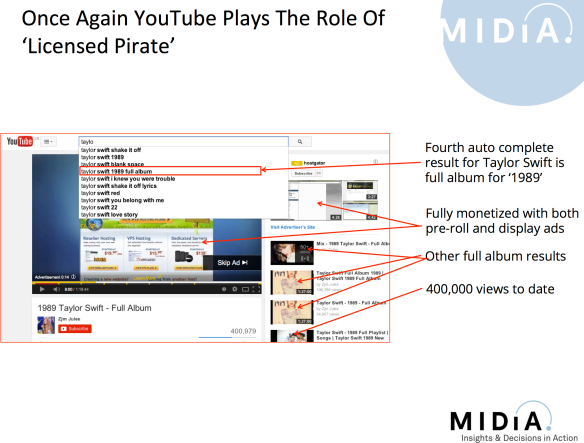Windowing, Shake It Off
By Mark Mulligan, this post originally appeared on MusicIndustryBlog.com
The removal of all of Taylor Swift’s albums from Spotify and other streaming services is sending minor shockwaves through the music industry. Swift’s label Big Machine has long adhered to a streaming windowing strategy and there is pretty compelling evidence that the approach has paid dividends. Swift’s ‘1989’ is not only on track to be the only million selling US album this year it is also set to have the highest ever first week album sales for a female artist, again in the US. No mean feat considering how much album sales have tanked. While it is impossible to prove the exact degree of causality, it would be fatuous to claim that windowing had done anything less than not hurt those sales. Windowing is an issue that refuses to go away but is a natural effect of the transition phase we are in.
Some artists and labels were just as fearful of iTunes in the 2000’s as they are now of Spotify. Heck, it took the Beatles seven whole years to finally license their catalogue. Right now there is still a very sizeable music sales marketplace. 79% of all recorded music revenue in 2013 came from sales. So it is understandable that some labels want to protect that Golden Goose as long as they can. And it is little compensation for labels that declining music sales are made up by increased live revenues. In even the most label friendly 360 deals music sales are still the core revenue stream.
However the shift to consumption models is an inevitable process. In the short term expect copy cat actions. Labels and artists will see the run away success of ‘1989’ and conclude that windowing played a key role. This may hurt Spotify just as it was beginning to feel good about proving its model. But the long view shows us that licensed streaming music will be ubiquitous five years from now, music sales will not. Even if Taylor Swift is still at the top of her game in 2019 she won’t be selling any 1 million albums anymore.
Spotify though can’t wait five years for Swift to shake off her streaming inhibitions. It can however help itself by accepting that its free tier should be on a different release window from its paid tier. If it doesn’t it makes windowing a binary equation which in turn makes it easier for an entire blanket ban to be conceived.
Of course the biggest irony in all this is that the free streaming services face no such blocks. All of Swift’s videos are still on YouTube and you can find her music all over Soundcloud, let alone Grooveshark. As MIDiA revealed last week, YouTube is one of the largest threats to music revenue. But because the music industry still views it as a marketing channel rather than a consumption channel it is measured by different standards. Thus 10 million YouTube views is a promotional success, whereas 10 million Spotify streams is x thousand lost sales. This hypocritical inconsistency has to end. Spotify premium customers are some of the most valuable music fans there are, most YouTube users are not.
And both YouTube and Soundcloud also fail to crack down on blatant misuse of their platforms. As the screen grab above shows, YouTube makes it easier than easy to access the full ‘1989’ album, which in this instance is fully monetized and has 400,000 views. Meanwhile Soundcloud also has the full album, this time conveniently presented as individual tracks. And even if / when UMG catches up with these infringing files, not only will more pop up, YouTube also has this, a full ‘1989’ playlist, full of non-infringing, Vevo videos. The simple fact is that too much is given away for free on YouTube. If Big Machine and Taylor Swift are really worried about cannibalizing album sales, they should take a long hard look at their YouTube strategy before pulling their content from Spotify.
UPDATE: UMG caught up with the 400,000 views full album YouTube video of ‘1989’ (that was quick) but the very same user has multiple other instances of the full ‘1989’ album which have hundreds of thousands of views and are still live.

I see an opportunity for subscription tiers:
– Charge $10 for full catalog, minus new releases
– Charge $15 to also get new releases. Look to the studio/theatrical exhibitor model for how to distribute that extra $5: label gets 100% in week 1, 90% week 2, 80% week 3, then new release is added to the general catalog (at 70%) in week 4
I would probably opt for the $15 tier – but my friends who aren’t all that into new music would be fine at $10 (and would let me tell them what to check out when it becomes available at their tier in week 4)